new posts in all blogs
Viewing: Blog Posts Tagged with: 2016 middle grade fiction, Most Recent at Top [Help]
Results 1 - 9 of 9
How to use this Page
You are viewing the most recent posts tagged with the words: 2016 middle grade fiction in the JacketFlap blog reader. What is a tag? Think of a tag as a keyword or category label. Tags can both help you find posts on JacketFlap.com as well as provide an easy way for you to "remember" and classify posts for later recall. Try adding a tag yourself by clicking "Add a tag" below a post's header. Scroll down through the list of Recent Posts in the left column and click on a post title that sounds interesting. You can view all posts from a specific blog by clicking the Blog name in the right column, or you can click a 'More Posts from this Blog' link in any individual post.
 No excuses! These are just the books that I read in 2016 that I thought knocked it out of the park. These aren’t the “best of the year”. These are just the books that were particularly good and that somehow crossed my radar. I read a lot more than what you’ll see here, but I loved these the best. For your consideration:
No excuses! These are just the books that I read in 2016 that I thought knocked it out of the park. These aren’t the “best of the year”. These are just the books that were particularly good and that somehow crossed my radar. I read a lot more than what you’ll see here, but I loved these the best. For your consideration:
Wonderful 2016 Children’s Novels
Cloud and Wallfish by Anne Nesbet
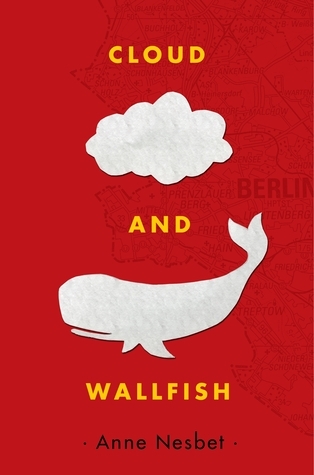
My dark horse Newbery front runner. I found it because Roger Sutton mentioned it off-handedly on his podcast, but it was Monica Edinger’s Horn Book review that got the most attention from the folks at Heavy Medal. It’s just the most delightful little Cold War, East Germany, book you could name. I’m gaga over it. If your kids read it, they will be too.
Five Children on the Western Front by Kate Saunders
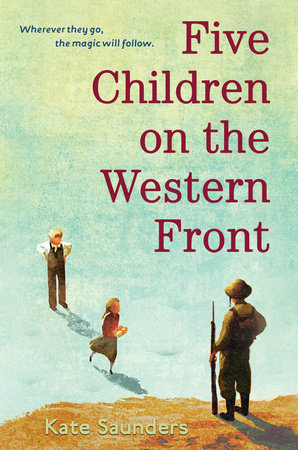
Again with the book recommendations from Monica! This time a couple years ago, when she found the English edition of this book. It came out this year with surprisingly little fanfare, but I just adored it. The question is whether or not kids unfamiliar with the works of E. Nesbit will get anything out of it. The eternal optimist, I vote yes! I mean, it’s about a tyrant finding its (his) soul. There’s something to that.
Full of Beans by Jennifer L. Holm

Funny that I never reviewed this one, but with Jenni Holm you sort of don’t have to. The woman’s masterful. To read her book is to marvel at how seemingly effortlessly she pulls various elements together. I will say that though this book is a prequel, you will not need to have read its predecessor to get anything out of it. It is, in a nutshell, sort of perfect.
Furthermore by Tahereh Mafi
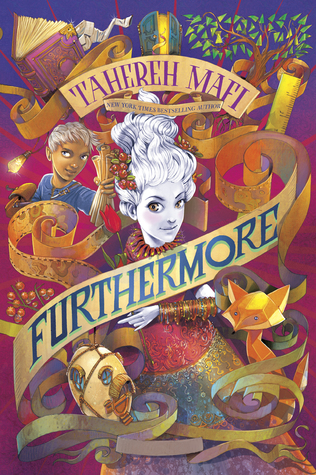
To ask anyone to craft a wholly original fantasy novel for kids is just setting that person up for a fall. If Mafi succeeds in any way here it is in her writing rather than her ideas. Not that her ideas aren’t interesting. They are, but it’s the characters, their interactions, and their personalities that sold it for me. It is infinitely readable and a lot of fun to boot. I like fun. I liked this book. I don’t hold it against it that it’s a New York Times bestseller either.
Ghost by Jason Reynolds
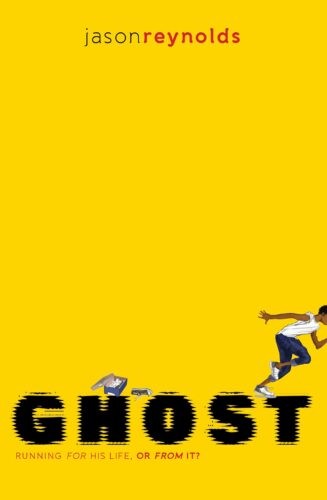
Years ago (three?) I said this Jason Reynolds guy was gonna be a star. I had a chance to hear him speak for the NYPL librarians after the publication of his first solo YA novel. In 2016 he started publishing middle grade in earnest and if he doesn’t win any major awards this year it’s simply a matter of time before he does in the future. I don’t know if Ghost is gonna take home a Newbery in any way, shape, or form. I just know that it was incredibly fun to read. One of my favorites of the year.
The Girl Who Drank the Moon by Kelly Barnhill

It’s anyone’s guess as to why it took me 8 months or so to finally pick this book up. When I saw Kelly speak at BookExpo here in Chicago this year I knew she was on to something. But to be perfectly frank, I’ve loved her work since she wrote The Mostly True Story of Jack (a book that I would contend still doesn’t get the attention and respect it deserves). I liked this one a lot. It’s a thick one, no question, but it also compelled me skip ahead a little just so that I could make sure that the villain wouldn’t win. There’s only one other book on this list this year that made me do that. I’ll let you guess what it was.
The Inn Between by Marina Cohen
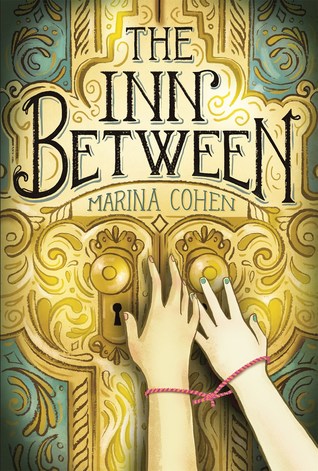
I include this book not because it’s some deep, insightful, heavily meaningful book fraught with consequence and award-worthy pain. No, this is just the kind of book I would have LOVED as a kid. I was the one who checked out all the Apple paperbacks that involved ghosts from my Scholastic Book Fair orders. So, naturally, this would have appealed. I mean, the back flap copy calls it “The Shining meets Hotel California” and that ain’t wrong. You’d never know it from the cutesy cover, though, would you? Someone needs a cover do-over.
The Inquisitor’s Tale by Adam Gidwitz
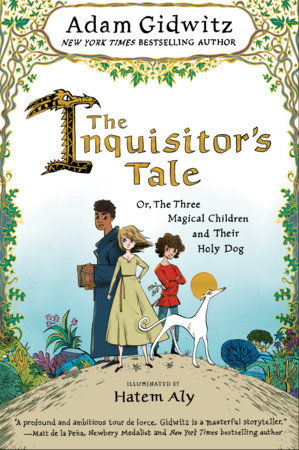
It doesn’t need my help. It never needed my help. But it’s wonderful and winning. Smarter than almost every other book on here by half. Gutsy. Challenging. And I can’t wait for the movie. I call dibs on Tom Hiddleston to play the King of France.
The Magic Mirror: Concerning a Lonely Princess, a Foundling Girl, a Scheming King and a Pickpocket Squirrel by Susan Hill Long

Poor little book. You were the first novel I read in 2016 and I came dangerously close to forgetting you here today. I liked this one very much, going so far as to say in my review that it was similar in tone to The Princess Bride. It actually makes a rather good pairing with THE GIRL WHO DRANK THE MOON, come to think of it. If you’ve a kid looking for light, frothy fantasy, this is the one to pick up.
Makoons by Louise Erdrich
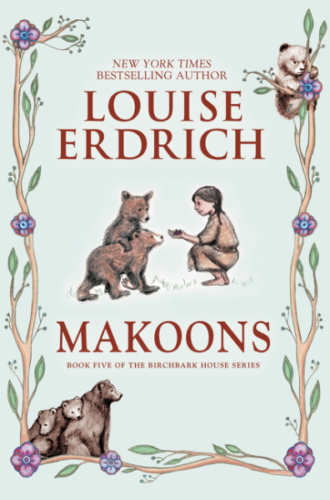
Does anyone ever point out how funny these books are? Yes, we all know Louise Erdrich to be a master writer, but she’s also incredibly hilarious when she wants to be. The latest book in the Birchbark House series did not disappoint and even gave us a few new characters. My favorite is the character done in by vanity, brought low, and ultimately redeemed. I’m a sucker for that kind of tale.
The Mighty Odds by Amy Ignatow
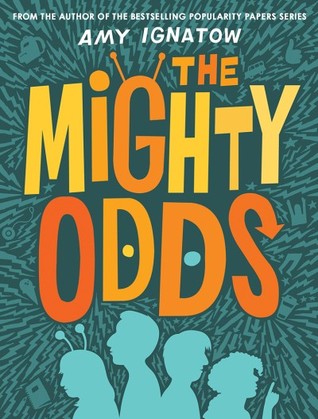
If you could have any superpower, would you choose the normal one or the weird one? If you chose the weird one then this book is for you. I think we’ve seen the outcasts-with-superpowers motif a lot (Spiderman, arguably, was one of the first) but I like Ignatow’s style so much that this is one of my current favs. How much do I love it? I actually bought a copy for my niece and I almost never ever buy books. What can I say? It was just that good.
Ms. Bixby’s Last Day by John David Anderson
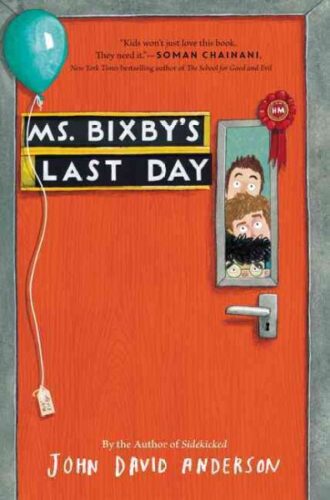
Not usually my kind of book but I liked Anderson’s Sidekicked years ago and figured that in spite of the description it might work for me. And it did! Granted, there’s more than a touch of Dead Poet’s Society to it, but all I cared was that it had an honest ending. An honest earned ending. This title doesn’t pander and I appreciate that. Worth discovering.
Pax by Sara Pennypacker
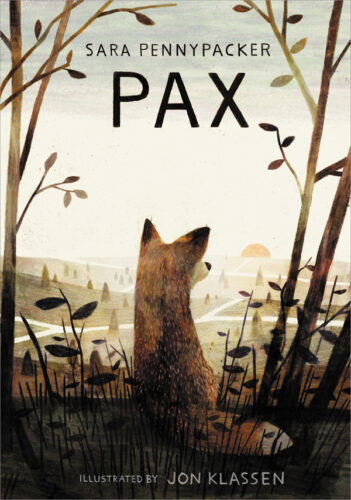
Can you believe this book came out in 2016? I feel as if we’ve been talking about it for two years. It’s still one of the strongest of the year, no matter what anybody says. When I was a child, I had a thing for foxes. Clearly I missed my era. If you’ve somehow managed to avoid reading this title, you have time to get your hands on it before award season. Do that thing.
Raymie Nightingale by Kate DiCamillo

While I would repeat that this book would be Because of Winn-Dixie if you dipped that book in a vat of sadness, that doesn’t mean it isn’t remarkable. I found it breathtakingly sad, but also smart. I didn’t care two bits for the main character (she’s remarkably forgettable) but the other characters just popped off the page. Quite a book.
Rebel Genius by Michael Dante DiMartino
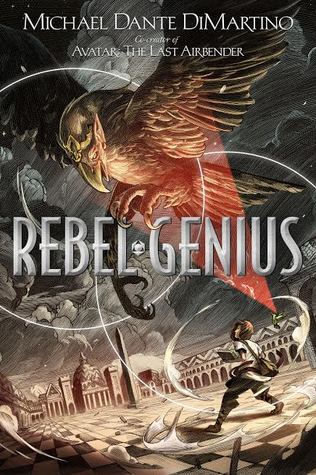
Poor action/adventure fans. What do I even have for you here today? Well, I have a fantasy novel coming from one of the co-creators of the Avatar: The Last Airbender television series, and that ain’t peanuts. Though it does come across as a slightly less scholarly His Dark Materials, I enjoyed the premise of Rebel Genius (a great title, if ever there was one). The big bad villain never makes an appearance but plenty of other baddies do. It’s compelling to its core.
When the Sea Turned to Silver by Grace Lin
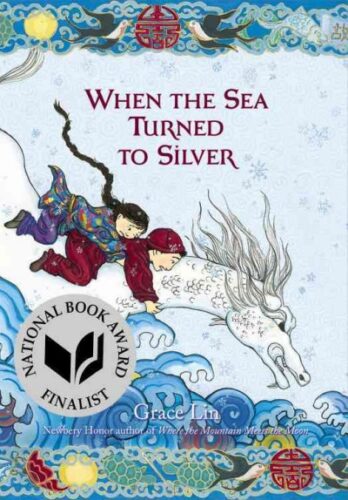
I just finished reading my daughter Where the Mountain Meets the Moon and wanted to just skip directly to this one, but Starry River of the Sky is next on our list and we shall not go out of order. Of the three books in the series, this is by far my favorite, and you certainly don’t have to have read the other books to enjoy it. Lin gets better and better with every book she writes. Annoying for her fellow authors, I’m sure, but great for the rest of us!
The Wild Robot by Peter Brown
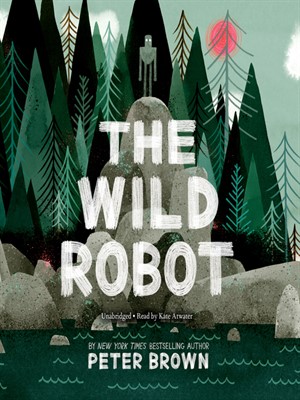
This marked Peter Brown’s debut as a novelist. Doesn’t seem quite fair that he should be able to write AND draw. Leave a little talent for the rest of us, won’t you, Peter? In any case, I’m all about the strong female heroines. So often in robot books the de facto pronoun is “he”. Brown made it “she” and it works for her. Better still, it works for us.
Wolf Hollow by Lauren Wolk
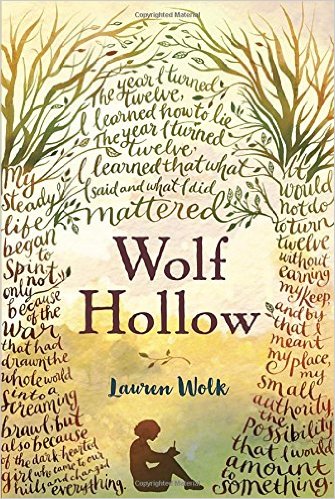
Remember earlier when I mentioned that there was one other book on this list that made me so tense I had to skip to the back to know precisely who would live, who would die, and what would become of the villain? Because the villain in this book does meet a terrible fate, but even so remains a cussed little wretch to the end. She is, without a doubt, the best villain I’ve encountered in a children’s book in years. A true blue psychopath. Best you know now.
Interested in the other lists of the month? Here’s the schedule so that you can keep checking back:


By:
Betsy Bird,
on 9/26/2016
Blog:
A Fuse #8 Production
(
Login to Add to MyJacketFlap)
JacketFlap tags:
Reviews,
Best Books,
Candlewick,
middle grade historical fiction,
Anne Nesbet,
Best Books of 2016,
2016 reviews,
Reviews 2016,
2016 middle grade fiction,
2017 Newbery contenders,
2016 middle grade historical fiction,
Add a tag
 Cloud and Wallfish
Cloud and Wallfish
By Anne Nesbet
Candlewick Press
$16.99
ISBN: 978-0-7636-8803-5
Ages 9-12
On shelves now
Historical fiction is boring. Right? That’s the common wisdom on the matter, certainly. Take two characters (interesting), give them a problem (interesting), and set them in the past (BOOOOOORING!). And to be fair, there are a LOT of dull-as-dishwater works of historical fiction out there. Books where a kid has to wade through knee-deep descriptions, dates, facts, and superfluous details. But there is pushback against this kind of thinking. Laurie Halse Anderson, for example, likes to call her books (Chains, Forge, Ashes, etc.) “historical thrillers”. People are setting their books in unique historical time periods. And finally (and perhaps most importantly) we’re seeing a lot more works of historical fiction that are truly fun to read. Books like The War That Saved My Life by Kimberly Brubaker Bradley, or One Crazy Summer by Rita Williams-Garcia, or My Near-Death Adventures by Alison DeCamp, or ALL of Louise Erdrich’s titles for kids. Better add Cloud and Wallfish by Anne Nesbet to that list as well. Doing what I can only characterize as the impossible, Nesbet somehow manages to bring East Germany in 1989 to full-blown, fascinating life. Maybe you wouldn’t want to live there, but it’s certainly worth a trip.
His name is Noah. Was Noah. It’s like this, one minute you’re just living your life, normal as you please, and the next your parents have informed you that your name is a lie, your birth date is wrong, and you’re moving to East Berlin. The year is 1989 and as Noah (now Jonah)’s father would say, there’s a definite smell of history in the air. His mother has moved the family to this new city as part of her research into education and stuttering (an impediment that Noah shares) for six months. But finding himself unable to attend school in a world so unlike the one he just left, the boy is lonely. That’s why he’s so grateful when the girl below his apartment, Claudia, befriends him. But there are secrets surrounding these new friends. How did Claudia’s parents recently die? Why are Noah’s parents being so mysterious? And what is going on in Germany? With an Iron Curtain shuddering on its foundations, Noah’s not just going to smell that history in the air. He’s going to live it, and he’s going to get a friend out of the bargain as well.
It was a bit of a risk on Nesbet’s part to begin the book by introducing us to Noah’s parents right off the bat as weirdly suspicious people. It may take Noah half a book to create a mental file on his mom, but those of us not related to the woman are starting our own much sooner. Say, from the minute we meet her. It was very interesting to watch his parents upend their son’s world and then win back his trust by dint of their location as well as their charm and evident love. It almost reads like a dare from one author to another. “I bet you can’t make a reader deeply distrust a character’s parents right from the start, then make you trust them again, then leave them sort of lost in a moral sea of gray, but still likable!” Challenge accepted!
Spoiler Alert on This Paragraph (feel free to skip it if you like surprises): Noah’s mom is probably the most interesting parent you’ll encounter in a children’s book in a long time. By the time the book is over you know several things. 1. She definitely loves Noah. 2. She’s also using his disability to further her undercover activities, just as he fears. 3. She incredibly frightening. The kind of person you wouldn’t want to cross. She and her husband are utterly charming but you get the distinct feeling that Noah’s preternatural ability to put the puzzle pieces of his life together is as much nature as it is nurture. Coming to the end of the book you see that Noah has sent Claudia postcards over the years from places all over the world. Never Virginia. One could read that a lot of different ways but I read it as his mother dragging him along with her from country to country. There may never be a “home” for Noah now. But she loves him, right? I foresee a lot of really interesting bookclub discussions about the ending of this book, to say nothing about how we should view his parents.
As I mentioned before, historical fiction that’s actually interesting can be difficult to create. And since 1989 is clear-cut historical fiction (this is the second time a character from the past shared my birth year in a children’s book . . . *shudder*) Nesbet utilizes several expository techniques to keep young readers (and, let’s face it, a lot of adult readers) updated on what precisely is going on. From page ten onward a series of “Secret Files” boxes will pop up within the text to give readers the low-down. These are written in a catchy, engaging style directly to the reader, suggesting that they are from the point of view of an omniscient narrator who knows the past, the future, and the innermost thoughts of the characters. So in addition to the story, which wraps you in lies and half-truths right from the start to get you interested, you have these little boxes of explanation, giving you information the characters often do not have. Some of these Secret Files are more interesting than others, but as with the Moby Dick portions in Louis Sachar’s The Cardturner, readers can choose to skip them if they so desire. They should be wary, though. A lot of pertinent information is sequestered in these little boxes. I wouldn’t cut out one of them for all the wide wide world.
Another way Nesbet keeps everything interesting is with her attention to detail. The author that knows the minutia of their fictional world is an author who can convince readers that it exists. Nesbet does this by including lots of tiny details few Americans have ever known. The pirated version of The Wonderful Wizard of Oz that was disseminated for years throughout the German Democratic Republic? I had no idea. The listing of television programs available there? Very funny (did I mention the book is funny too?). Even the food you could get in the grocery store and the smell of the coal-choked air feels authentic.
Of course, you can load your book down with cute boxes and details all day and still lose a reader if they don’t relate to the characters. Noah could easily be reduced to one of those blank slate narrators who go through a book without a clear cut personality. I’m happy to report that this isn’t the case here. And I appreciated the Claudia was never a straight victim or one of those characters that appears impervious to the pain in her life. Similarly, Noah is a stutterer but the book never throws the two-dimensional bully in his path. His challenges are all very strange and unique to his location. I was also impressed by how Nesbet dealt with Claudia’s German (she makes up words or comes up with some Noah has never heard of and so Nesbet has the unenviable job of making that clear on the page). By the same token, Noah has a severe stutter, but having read the whole book I’m pretty sure Nesbet only spells the stutter out on the page once. For every other time we’re told about it after the fact or as it is happening.
I’ve said all this without, somehow, mentioning how lovely Nesbet’s writing is. The degree to which she’s willing to go deep into her material, plucking out the elements that will resonate the most with her young readers, is masterful. Consider a section that explains what it feels like to play the role of yourself in your own life. “This is true even for people who aren’t crossing borders or dealing with police. Many people in middle school, for instance, are pretending to be who they actually are. A lot of bad acting is involved.” Descriptions are delicious as well. When Claudia comes over for dinner after hearing about the death of her parents Nesbet writes, “Underneath the bristles, Noah could tell, lurked a squishy heap of misery.”
There’s little room for nuance in Nesbet’s Berlin, that’s for sure. The East Berliners we meet are either frightened, in charge, or actively rebelling. In her Author’s Note, Nesbet writes about her time in the German Democratic Republic in early 1989, noting where a lot of the details of the book came from. She also mentions the wonderful friends she had there at that time. Noah, by the very plot in which he finds himself, would not be able to meet these wonderful people. As such, he has a black-and-white view of life in East Berlin. And it’s interesting to note that when his classmates talk up the wonders of their society, he never wonders if anything they tell him is true. Is everyone employed? At what price? There is good and bad and if there is nuance it is mostly found in the characters like Noah’s mother. Nesbet herself leaves readers with some very wise words in her Author’s Note when she says to child readers, “Truth and fiction are tangled together in everything human beings do and in every story they tell. Whenever a book claims to be telling the truth, it is wise (as Noah’s mother says at one point) to keep asking questions.” I would have liked a little more gray in the story, but I can hardly think of a better lesson to impart to children in our current day and age.
In many way, the book this reminded me of the most was Katherine Paterson’s Bridge to Terabithia. Think about it. A boy desperate for a friend meets an out-of-the-box kind of girl. They invent a fantasyland together that’s across a distinct border (in this book Claudia imagines it’s just beyond the Wall). Paterson’s book was a meditation on friendship, just like Nesbet’s. Yet there is so much more going on here. There are serious thoughts about surveillance (something kids have to think about a lot more today), fear, revolution, loyalty, and more than all this, what you have to do to keep yourself sane in a world where things are going mad. Alice Through the Looking Glass is referenced repeatedly, and not by accident. Noah has found himself in a world where the rules he grew up with have changed. As a result he must cling to what he knows to be true. Fortunately, he has a smart author to help him along the way. Anne Nesbet always calls Noah by his own name, even when her characters don’t. He is always Noah to us and to himself. That he finds himself in one of the most interesting and readable historical novels written for kids is no small thing. Nesbet outdoes herself. Kids are the beneficiaries.
On shelves now.
Source: Galley sent from publisher for review.
Like This? Then Try:
Professional Reviews:


By:
Betsy Bird,
on 8/10/2016
Blog:
A Fuse #8 Production
(
Login to Add to MyJacketFlap)
JacketFlap tags:
Reviews,
middle grade fiction,
Simon and Schuster,
Atheneum,
Best Books,
middle grade realistic fiction,
Jason Reynolds,
Best Books of 2016,
2016 reviews,
Reviews 2016,
2016 middle grade fiction,
2016 realistic fiction,
diverse fiction,
Add a tag
 Ghost
Ghost
By Jason Reynolds
Atheneum (an imprint of Simon & Schuster)
$16.99
ISBN: 978-1-4814-5015-7
Ages 9-12
On shelves August 30th
This is a generalization, but in my experience librarians really enjoy reading within their comfort zones. They’ll travel outside of them from time to time but always they return to the books that they like the most. Children’s librarians are just the same. The fantasy readers stick to fantasy. The realism fans go with realism. Graphic novel readers with comics. When I served on a yearly committee of librarians in New York I’d notice that some books were difficult to get anyone to read. Horse books, for example, just sat on our shelves untouched. Nonfiction could take some prodding. And as for sports books . . . forget about it. Nobody ever got near them. Still, you can’t give up on them. Mike Lupica and Tim Green may rule the field but that doesn’t mean other people don’t make a lot out of athletics. If our Newbery winning The Crossover by Kwame Alexander taught us anything, it was that. Now Jason Reynolds, a young adult author until this year, has produced a middle grade novel centered on that must unlikely of sports: track. It skirts the clichés. It dodges the usual pitfalls. It makes you care about a kid who keeps messing up over and over and over again. It’ll make you like sports books, even if you can’t generally stand them. And now we’ve got to find a way to get a lot of it into the hands of kids. Stat.
Call him Ghost. You can call him Castle Crenshaw if you want to (that’s technically his name) but he’s been calling himself Ghost ever since the night his dad got drunk and threatened Castle and his mom with a gun. Ghost learned to run that night and you might say he’s been running ever since. He’s got a load of anger inside that he doesn’t know how to deal with so he tends to take it out on others at school. Then one day he spots a track warm-up and takes an instant dislike to the albino kid in the expensive tracksuit. Without thinking about it twice Ghost beats the guy on the track, running on the outside, which gets the attention of the coach. Coach begs Ghost to join and Ghost reluctantly agrees but it isn’t what he expected. The other kids there all have their own lives, few of them easy. The running is much harder than anything Ghost has ever experienced before. And then there’s the fact that no matter how fast he is, Ghost can’t run away from trouble. It follows him and if he’s not careful it’s going to follow him right onto the track.
Baseball. Basketball. Even football. These are the sports of fiction. I doubt anyone has ever run any statistics on it, but if you were to gather together all the children’s sports books and group them by type, the baseball books would undoubtedly outweigh all the others 2:1. That’s because baseball is a game with a natural rise and fall to its action. Basketball has speed and football has brute force, all good things when writing a story. Track? In track you run and then you stop. At least that’s how I always looked at it. For Jason Reynolds, though, it’s different. He didn’t write this book with track as a single focus. He looks at what the sport boils down to. Basically, this is a book about running. Running from mistakes (forgive the cliché), from very real threats, for your life, and for your team. Why you run and where you run and how you run. And if that’s where you’re coming from, then track is a very good choice of a sport indeed.
On paper, this book looks like it’s the sort of story that’s all been done before. That’s where Reynolds’ writing comes in to play. First off, it’s worth noticing that Mr. Reynolds is blessed with a keen sense of humor. This comes to play not just in the text but also in little in-jokes here and there. Like the fact that one of the runners (that, I should mention, gets cut later in the book because his grades are slipping) is named Chris Myers. Christopher Myers is the son of Walter Dean Myers, and a friend to Jason Reynolds. I love Jason’s descriptions too. Mr. Charles at the corner store, “looks just like James Brown if James Brown were white. . .” Or Ghost saying later, “… for something to make you feel tough, you gotta be a little bit scared of it at first.” There are some pretty fantastic callbacks hidden in the story as well. Right at the start, almost like it’s some kind of superhero origin story, we hear how Ghost heard the gun go off that night he ran away from his home with his mom and “I felt like the loud shot made my legs move even faster.” That ties in beautifully with the starter pistol that goes off at the very very end of the book.
But maybe what I like the most about Jason Reynolds’ books is that he applies this keen sense of the complexity to his characters. I don’t think the man could write a straight one-dimensional villain to save his soul. Even his worst characters have these brief moments of humanity to them. In this case, Ghost’s dad is the worst character. You don’t get much worse than shooting at your wife and kid after all. Yet for all that, Ghost still can’t help but love the guy and eats sunflower seeds in his memory. Each character in the book has layers that you can peel away as the story progresses. Even Ghost, ESPECIALLY Ghost, who makes you want to yell and him and cheer for him, sometimes at the same time.
There’s been a monumental push for increased diversity in children’s literature in the last few years. Diversity can mean any number of things and it often focuses on race. In a weird way, increasing the number of racially diverse books on a given publisher’s release calendar isn’t hard if the publisher is dedicated to the notion. Far more difficult is figuring out how you increase the economic diversity. Middle grade characters are almost always middle class. If they’re working class then they tend to be historical. Contemporary lower income kids in realistic novels are almost unheard of. For example, how many books for children have you ever read with kids living in shelters? I’ve read just one, and I’m a children’s librarian. So I watched what Reynolds did here with great interest. Ghost isn’t destitute or anything but his single mom makes ends meet by working long hours at a hospital. Middle class kids are remarkably good at ignoring their own privilege while kids like Ghost become almost invisible. In the book, Ghost’s decision to initially race Lu isn’t solely based on how Lu struts around the track, thinking he’s the bee’s knees. It’s also on his clothes. “…Lu, was decked out in the flyest gear. Fresh Nike running shoes, and a full-body skintight suit . . . He wore a headband and a gold chain around his neck, and a diamond glinted in each ear.” Later Ghost makes a decision regarding a particularly fancy pair of running shoes. That’s an economic decision as well. Those are the most obvious examples, but the book is full of little mentions, peppered throughout, of where Ghost’s class comes in to things. It’s nice to see an author who gets that. We are often affected by forces outside our control, forces we don’t even necessarily notice, particularly when we’re children. If young readers see it, they’ll be reading between the lines, just like Reynolds wants them to.
Right at the beginning of the book, when Coach is trying to convince Ghost’s mom that he should be running, Ghost realizes that he’s in a situation that’s played out in loads of sports films. He thinks, “If this went like the movies, I was either going to score the game-winning touchdown (which is impossible in track) or . . . die.” Sometimes you can gauge how good a book is by how self-aware its characters are. But sometimes you just read a book, put it down, and think, “Man. That was good. That was really good.” This is a book that actually made me tear up, and there aren’t a lot of middle grade books that do that. I was rooting for Ghost hard, right until the end. I was caring about a sport that I’d never otherwise think about in a million years. And I was admiring it from start to finish for all that it accomplishes in its scant 180 pages. This is the book you hand to the kids who want something real and good and honest. There are a lot of Ghosts out there in the world. Hopefully some of them will discover themselves here. Run, don’t walk, to pick this book up.
On shelves August 30th.
Source: Galley sent from publisher for review.
Like This? Then Try:


By:
Betsy Bird,
on 7/21/2016
Blog:
A Fuse #8 Production
(
Login to Add to MyJacketFlap)
JacketFlap tags:
Reviews,
middle grade fantasy,
funny books,
Best Books,
abrams,
Amulet Books,
Amy Ignatow,
middle school novels,
middle school fantasy,
funny fantasy,
Best Books of 2016,
Reviews 2016,
2016 middle grade fantasy,
2016 middle grade fiction,
2016 funny books,
2016 middle school fiction,
Add a tag
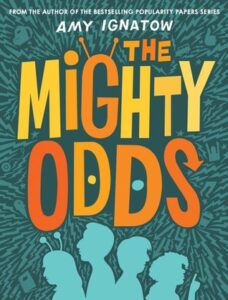 The Mighty Odds
The Mighty Odds
By Amy Ignatow
Amulet Books (an imprint of Abrams)
$15.95
ISBN: 978-1-4197-1271-5
Ages 10 and up
On shelves September 13th
If you could have one weird superpower, what would it be? Not a normal one, mind you. We’re not doing a flight vs. invisibility discussion here. The power would have to be extraordinary and odd. If it’s completely useless, all the better. Me? I think I’d like my voice to be same as the voice you hear in your head when you’re reading something. You know that voice? That would be my superpower. A good author can crank this concept up to eleven if they want to. Enter, Amy Ignatow. She is one of the rare authors capable of making me laugh out loud at the back covers of her books. For years she’s penned The Popularity Papers to great success and acclaim. Now that very realistic school focus is getting a bit of a sci-fi/fantasy kick in the pants. In The Mighty Odds, Ignatow takes the old misfits-join-together-to-save-the-world concept and throws in a lot of complex discussions of race, middle school politics, bullying, and good old-fashioned invisible men. The end result is a 21st century superhero story for kids that’s keeps you guessing every step of the way.
A school bus crashes in a field. No! Don’t worry! No one is killed (that we can tell). And the bus was just full of a bunch of disparate kids without any particular connection to one another. There was the substitute teacher and the bus driver (who has disappeared). And there was mean girl Cookie (the only black girl in school and one of the most popular), Farshad (nicknamed “Terror Boy” long ago by Cookie), Nick (nerdy and sweet), and Martina (the girl no one notices, though she’s always drawing in her sketchbook). After the accident everything should have just gotten back to normal. Trouble is, it didn’t. Each person who was on or near the bus when the accident occurred is a little bit different. It might be a small thing, like the fact that Martina’s eyes keep changing color. It might be a weird thing, like how Cookie can read people’s minds when they’re thinking of directions. It might be a powerful thing, like Farad’s super strength in his thumbs. Or it might be a potentially powerful, currently weird thing like Nick’s sudden ability to teleport four inches to his left. And that’s before they discover that someone is after them. Someone who means them harm.
Superhero misfits are necessarily new. Remember Mystery Men? This book reminded me a lot of that old comic book series / feature film. In both cases superpowers are less a metaphor and more a vehicle for hilarity. I read a lot of books for kids but only once in a while do I find one enjoyable enough to sneak additional reads of on the sly. This book hooked me fairly early on, and I credit its sense of humor for that. Here’s a good example of it. Early in the book Cookie and a friend are caught leaving the field trip for their own little side adventure. The kids in their class speculate what they got up to and one says that clearly they got drunk. Farshad’s dry wit then says, “… because two twelve-year-olds finding a bar in Philadelphia that would serve them at eleven A.M. was completely plausible.” Add in the fact that they go to “Deborah Read Middle School” (you’ll have to look it up) and I’m good to go.
Like I’ve said, the book could have just been another fun, bloodless superhero misfit storyline. But Ignatow likes challenges. When she wrote the Popularity Papers books she gave one of her two heroines two dads and then filled the pages with cursive handwriting. Here, her heroes are a variety of different races and backgrounds, but this isn’t a Benetton ad. People don’t get along. Cookie’s the only black kid in her school and she’s been very careful to cement herself as popular from the start. When her mom moved them to Muellersville, Cookie had to be careful to find a way to become “the most popular and powerful person in school.” Martina suggests at one point that she likes being angry, and indeed when the world starts to go crazy on her the thing that grounds her, if only for a moment, is anger. And why shouldn’t she be angry? Her mom moved her away from her extended family to a town where she knew no one, and then her mother married a guy with two kids fairly fast. Cookie herself speculates about the fact that she probably has more in common with Farshad than she’d admit. “He was the Arab Kid, just like Cookie was the Black Girl and Harshita Singh was the Indian Girl and Danny Valdez was the Hispanic Guy and Emma Lee was the Asian Chick. They should have all formed a posse long ago and walked around Muellersville together, just to freak people out.” Cookie realizes that she and Farshad need to have one another’s backs. “It was one thing to be a brown person in Muellersville and another to be a brown person in Muellersville with superpowers.” At this point in time Ignatow doesn’t dig any deeper into this, but Cookie’s history, intentions, and growth give her a depth you won’t find in the usual popular girl narrative.
For the record, I have a real appreciation for contemporary books that feature characters that get almost zero representation in books. For example, one of the many things I love about Tom Angleberger’s The Qwikpick Papers series is that one of the three heroes is Jehovah’s Witness. In this book, one of the kids that comes to join our heroes is Amish. Amish kids are out there. They exist. And they almost never EVER get heroic roles in stories about a group of friends. And Abe doesn’t have a large role in this book, it’s true, but it’s coming.
Having just one African-American in the school means that you’re going to have ignorant other characters. Cookie has done a good job at getting the popular kids in line, but that doesn’t mean that everyone is suddenly enlightened. Anyone can be tone deaf. Even one of our heroes, which in this case means Nick’s best friend, the somewhat ADD, always chipper Jay. Now I’ve an odd bit of affection for Jay, and not just because in his endless optimism he honestly thinks he’ll get permission to show his class Evil Dead Two on the field trip bus (this may also mark the first time an Evil Dead film has been name dropped in a middle grade novel, by the way). The trouble comes when he talks about Cookie. He has a tendency to not just be tone deaf but veering into really racially questionable territory when he praises her. Imagine a somewhat racist Pepe Le Pew. That’s Jay. He’s a small town kid who’s only known a single solitary black person his entire life and he’s enamored with her. Still, that’s no excuse for calling her “my gorgeous Nubian queen” or saying someday they’ll “make coffee-colored babies.” I expected a little more a comeuppance for Jay and his comments, but I suppose that’ll have to wait for a future book in the series. At the very least, his words are sure to raise more than few eyebrows from readers.
Funny is good. Great even. But funny doesn’t lift a middle grade book out of the morass of other middle grade books that are clogging up the bookstores and libraries of the world. To hit home you need to work just a smidgen of heart in there. A dose of reality. Farad’s plight as the victim of anti-Muslim sentiment is very real, but it’s also Nick’s experiences with his dying/dead father that do some heavy lifting. As you get to know Nick, Ignatow sprinkles hints about his life throughout the text in a seamless manner. Like when Nick is thinking about weird days in his life and flashes back to the day after his dad’s funeral. He and his mom had “spent the entire day flopped on the couch, watching an impromptu movie marathon of random films (The Lord of the Rings, They Live, Some Like It Hot, Ghostbusters, and Babe) and eating fancy stuff from the gift baskets that people had sent, before finally getting up to order pizza.” There’s a strong smack of reality in that bit, and there are more like it in the book. A funny book that sucker punches your heart from time to time makes for good reading.
 Lest we forget, this is an illustrated novel. Ignatow makes the somewhat gutsy choice of not explaining the art for a long time. Long before we even get to know Martina, we see her in various panels and spreads as an alien. In time, we learn that the art in this book is all her art, and that she draws herself as a Martian because that’s what her sister calls her. Not that you’ll know any of this for about 125 pages. The author makes you work to get at that little nugget of knowledge. By the way, as a character, Martina the artist is fascinating. She’s sort of the Luna Lovegood of the story. Or, as Nick puts it, “She had a sort of almost absentminded way of saying things that shouldn’t have been true but probably were.” There is one tiny flub in the art when Martina draws all the kids as superheroes and highlights Farshad’s thumbs, though at that point in the storyline Martina wouldn’t know that those are his secret weapons. Other than that, it’s pretty perfect.
Lest we forget, this is an illustrated novel. Ignatow makes the somewhat gutsy choice of not explaining the art for a long time. Long before we even get to know Martina, we see her in various panels and spreads as an alien. In time, we learn that the art in this book is all her art, and that she draws herself as a Martian because that’s what her sister calls her. Not that you’ll know any of this for about 125 pages. The author makes you work to get at that little nugget of knowledge. By the way, as a character, Martina the artist is fascinating. She’s sort of the Luna Lovegood of the story. Or, as Nick puts it, “She had a sort of almost absentminded way of saying things that shouldn’t have been true but probably were.” There is one tiny flub in the art when Martina draws all the kids as superheroes and highlights Farshad’s thumbs, though at that point in the storyline Martina wouldn’t know that those are his secret weapons. Other than that, it’s pretty perfect.
It’s also pretty clearly middle school fare, if based on language alone. You’ve got kids leaving messages on cinderblocks that read “Nolite te bastardes carborundorum” or “Don’t let the bastards get you down.” That may be the most realistic middle school detail I’ve read in a book in a long time. The bullying is systematic, realistic, and destructive (though that’s never clear to the people doing the bullying). A little more hard core than what an elementary school book might discuss. And Cookie is a superb bully. She’s honestly baffled when Farad confronts her about what she’s done to him with her rumors.
A word of warning to the wise: This is clearly the first book in a longer series. When you end this tale you will know the characters and know their powers but you still won’t know who the bad guys are exactly, why the kids got their powers (though the bus driver does drop one clue), or where the series is going next. For a story where not a lot of time passes, it really works the plotting and strong characterizations in there. I like middle grade books that dream big and shoot for the moon. “The Mighty Odds” does precisely that and also works in some other issues along the way. Just to show that it can. Great, fun, silly, fantastical fantasy work. A little smarter and a little weirder than most of the books out there today.
On shelves September 13th.
Source: Galley sent from publisher for review.
Readalikes:
Professional Reviews:


By:
Betsy Bird,
on 7/6/2016
Blog:
A Fuse #8 Production
(
Login to Add to MyJacketFlap)
JacketFlap tags:
Reviews,
middle grade fiction,
Best Books,
Dutton Children's Books,
middle grade historical fiction,
Adam Gidwitz,
Penguin Random House,
Hatem Aly,
Best Books of 2016,
2016 reviews,
Reviews 2016,
2016 middle grade fiction,
2016 middle grade historical fiction,
Add a tag
 The Inquisitor’s Tale or, The Three Magical Children and Their Holy Dog
The Inquisitor’s Tale or, The Three Magical Children and Their Holy Dog
By Adam Gidwitz
Illuminated by Hatem Aly
Dutton Children’s Books (an imprint of Penguin Random House)
$17.99
ISBN: 978-0-525-42616-5
Ages 9 and up
On shelves September 27th
God’s hot this year.
To be fair, God has had some fairly strong supporters for quite some time. So if I’m going to clarify that statement a tad, God’s hot in children’s literature this year. Even then, that sentence is pretty vague. Here in America there are loads of Christian book publishers out there, systematically putting out title after title after title each and every year about God, to say nothing of publishers of other religions as well. Their production hasn’t increased hugely in 2016, so why the blanket statement? A final clarification, then: God is hot in children’s books from major non-Christian publishers this year. Ahhhh. That’s better. Indeed, in a year when serious literary consideration is being heaped upon books like John Hendrix’s Miracle Man, in walks Adam Gidwitz and his game changing The Inquisitor’s Tale. Now I have read my fair share of middle grade novels for kids, and I tell you straight out that I have never read a book like this. It’s weird, and unfamiliar, and religious, and irreligious, and more fun than it has any right to be. Quite simply, Gidwitz found himself a holy dog, added in a couple proto-saints, and voila! A book that’s part superhero story, part quixotic holy quest, and part Canterbury Tales with just a whiff of intrusive narration for spice. In short, nothing you’ve encountered in all your livelong days. Bon appétit.
The dog was dead to begin with. A greyhound with a golden muzzle that was martyred in defense of a helpless baby. As various pub goers gather in the year 1242 to catch a glimpse of the king, they start telling stories about this dog that came back from the dead, its vision-prone mistress (a peasant girl named Jeanne), a young monk blessed with inhuman strength (William, son of a lord and a North African woman), and a young Jewish boy with healing capabilities (Jacob). These three very different kids have joined together in the midst of a country in upheaval. Some see them as saints, some as the devil incarnate, and before this tale is told, the King of France himself will seek their very heads. An extensive Author’s Note and Annotated Bibliography appear at the end.
If you are familiar with Mr. Gidwitz’s previous foray into middle grade literature (the Grimm series) then you know he has a penchant for giving the child reader what it wants. Which is to say, blood. Lots of it. In his previous books he took his cue from the Grimm brothers and their blood-soaked tales. Here his focus is squarely on the Middle Ages (he would thank you not to call them “The Dark Ages”), a time period that did not lack for gore. The carnage doesn’t really begin in earnest until William starts (literally) busting heads, and even then the book feels far less sanguine than Gidwitz’s other efforts. I mean, sure, dogs die and folks are burned alive, but that’s pretty tame by Adam’s previous standards. Of course, what he lacks in disembowelments he makes up for with old stand-bys like vomit and farts. Few can match the man’s acuity for disgusting descriptions. He is a master of the explicit and kids just eat that up. Not literally of course. That would be gross. As a side note, he has probably included the word “ass” more times in this book than all the works of J.M. Barrie and Roald Dahl combined. I suspect that if this book is ever challenged in schools or libraries it won’t be for the copious entrails or discussions about God, but rather because at one point the word “ass” (as it refers to a donkey) appears three times in quick, unapologetic succession. And yes, it’s hilarious when it does.
So let’s talk religious persecution, religious fundamentalism, and religious tolerance. As I write this review in 2016 and politicians bandy hate speech about without so much as a blink, I can’t think of a book written for kids more timely than this. Last year I asked a question of my readers: Can a historical children’s book contain protagonists with prejudices consistent with their time period? Mr. Gidwitz seeks to answer that question himself. His three heroes are not shining examples of religious tolerance born of no outside influence. When they escape together they find that they are VERY uncomfortable in one another’s presence. Mind you, I found William far more tolerant of Jacob than I expected (though he does admittedly condemn Judaism once in the text). His dislike of women is an interesting example of someone rejecting some but not all of the childhood lessons he learned as a monk. Yet all three kids fear one another as unknown elements and it takes time and a mutually agreed upon goal to get them from companionship to real friendship.
As I mentioned at the start of this review, religion doesn’t usually get much notice in middle grade books for kids from major publishers these days. And you certainly won’t find discussions about the differences between Christianity and Judaism, as when the knight Marmeluc tries to determine precisely what it is to be Jewish. What I appreciated about this book was how Gidwitz distinguished between the kind of Christianity practiced by the peasants versus the kind practiced by the educated and rich. The peasants have no problem worshipping dogs as saints and even the local priest has a wife that everyone knows he technically isn’t supposed to have. The educated and rich then move to stamp out these localized beliefs which, let’s face it, harken back to the people’s ancestors’ paganism.
Race also comes up a bit, with William’s heritage playing a part now and then, but the real focus is reserved for the history of Christian/Jewish interactions. Indeed, in his wildly extensive Author’s Note at the end, Gidwitz makes note of the fact that race relations in Medieval Europe were very different then than today. Since it preceded the transatlantic slave trade, skin color was rare and contemporary racism remains, “the modern world’s special invention.” There will probably still be objections to the black character having the strength superpower rather than the visions or healing, but he’s also the best educated and intelligent of the three. I don’t think you can ignore that fact.
As for the writing itself, that’s what you’re paying your money for at the end of the day. Gidwitz is on fire here, making medieval history feel fresh and current. For example, when the Jongleur says that some knights are, “rich boys who’ve been to the wars . . . Not proper at all. But still rich,” that’s a character note slid slyly into the storytelling. Other lines pop out at you too. Here are some of my other favorites:
• About that Jongleur, “… he looks like the kind of child who has seen too much of life, who’s seen more than most adults. His eyes are both sharp and dead at the same time. As if he won’t miss anything, because he’s seen it all already.”
• “Jeanne’s mother’s gaze lingered on her daughter another moment, like an innkeeper waiting for the last drop of ale from the barrel tap.”
• “The lord and lady welcomed the knights warmly. Well, the lady did. Lord Bertulf just sat in his chair behind the table, like a stick of butter slowly melting.”
• “Inside her, grand castles of comprehension, models of the world as she had understood it, shivered.”
• And Gidwitz may also be the only author for children who can write a sentence that begins, “But these marginalia contradicted the text…” and get away with it.
Mind you, Gidwitz paints himself into a pretty little corner fairly early on. To rest this story almost entirely on the telling of tales in a pub, you need someone who doesn’t just know the facts of one moment or the next but who could claim to know our heroes’ interior life. So each teller comes to mention each child’s thoughts and feelings in the course of their tale. The nun in the book bears the brunt of this sin, and rather than just let that go Gidwitz continually has characters saying things like, “I want to know if I’m sitting at a table filled with wizards and mind readers.” I’m not sure if I like the degree to which Gidwitz keeps bringing this objection up, or if it detracts from the reading. What I do know is that he sort of cheats with the nun. She’s the book’s deux ex machina (or, possibly the diaboli ex machina) acting partly as an impossibility and partly as an ode to the author’s love of silver haired librarians and teachers out there with “sparkling eyes, and a knowing smile.”
Since a large portion of the story is taken up with saving books as objects, it fits that this book itself should be outfitted with all the beauties of its kind. If we drill down to the very mechanics of the book, we find ourselves admiring the subtleties of fonts. Every time a tale switches between the present day and the story being told, the font changes as well. But to do it justice, the story has been illuminated (after a fashion) by artist Hatem Aly. I have not had the opportunity to see the bulk of his work on this story. I do feel that the cover illustration of William is insufficiently gargantuan, but that’s the kind of thing they can correct in the paperback edition anyway.
Fairy tales and tales of saints. The two have far more in common than either would like to admit. Seen in that light, Gidwitz’s transition from pure unadulterated Grimm to, say, Lives of the Improbable Saints and Legends of the Improbable Saints is relatively logical. Yet here we have a man who has found a way to tie-in stories about religious figures to the anti-Semitism that is still with us to this day. At the end of his Author’s Note, Gidwitz mentions that as he finished this book, more than one hundred and forty people were killed in Paris by terrorists. He writes of Medieval Europe, “It was a time when people were redefining how they lived with the ‘other,’ with people who were different from them.” The echoes reverberate today. Says Gidwitz, “I can think of nothing sane to say about this except this book.” Sermonizers, take note.
On shelves September 27th.
Like This? Then Try:


By:
Betsy Bird,
on 6/2/2016
Blog:
A Fuse #8 Production
(
Login to Add to MyJacketFlap)
JacketFlap tags:
Best Books,
bedtime books,
Little Brown and Company,
Peter Brown,
Best Books of 2016,
2016 reviews,
Reviews 2016,
2016 middle grade fiction,
2016 middle grade science fiction,
2016 science fiction,
science fiction,
Reviews,
Add a tag
 The Wild Robot
The Wild Robot
By Peter Brown
Little, Brown & Company
$16.99
ISBN: 978-0-316-38199-4
Ages 9-12
On shelves now
There are far fewer robot middle grade books out there than you might expect. This is probably because, as a general rule, robots fall into the Data from Star Trek trap. Their sole purpose in any narrative is to explain what it is to be human. You see this all the time in pop culture, so it stands to reason you’d see it a bit in children’s books too. Never you mind that a cool robot is basically a kid’s dream companion. Take away the kid, put the robot on its own, and you have yourself some philosophy lite. Maybe that’s why I liked Peter Brown’s The Wild Robot as much as I did. The heroine of this book is mechanical but she’s not wrestling with the question of what it means to feel emotions or any of that. She’s a bit more interested in survival and then, after a bit of time, connection. Folks say this book is like Hatchet or My Side of the Mountain. Maybe so, but it’s also a pretty good book about shedding civilization and going wild. In short, living many a city kid’s dream.
The first thing she is aware of is that she is bound in a crate by cords. Once those are severed she looks about. Roz is a robot. She appears to be on an island in the sea. Around her are the shattered remains of a good many other robots. How she has gotten here, she doesn’t know, but it doesn’t take long for her to realize that she is in dire need of shelter and allies. Roz is not a robot built for the outdoors, but part of her programming enables her to adapt. Learning the languages of the denizens of the forest, Roz is initially rebuffed (to put it mildly) by the animals living there. After a while, though, she adopts a gosling she accidentally orphaned and together they learn, grow, and come to be invaluable members of the community. And when Roz faces a threat from the outside, it’s her new friends and extended family that will come to her aid.
 They say that all good stories can be easily categorized into seven slots. One of the best known is “a stranger comes to town”. Roz is precisely that and her story is familiar in a lot of ways. The stranger arrives and is shunned or actively opposed. Then they win over the local populace and must subsequently defend it against an incoming enemy or be protected by it. But there is another kind of book this conjures up as well. The notion of going from “civilized” to “wild” carries the weight of all kinds of historical appropriations. Smart of Brown then to stick with robots and animals. Roz is a kind of anti-Pinocchio. Instead of trying to figure out how to fit in better with civilization, she spends the bulk of her time trying to figure out how to shed it like a skin. In his career, Brown has wrestled continually with the notion of civilization vs. nature, particularly as it relates to being “wild”. The most obvious example of this, prior to The Wild Robot, was his picture book Mr. Tiger Goes Wild. Yet somehow it manages to find its way into many of the books he does. Consider the following:
They say that all good stories can be easily categorized into seven slots. One of the best known is “a stranger comes to town”. Roz is precisely that and her story is familiar in a lot of ways. The stranger arrives and is shunned or actively opposed. Then they win over the local populace and must subsequently defend it against an incoming enemy or be protected by it. But there is another kind of book this conjures up as well. The notion of going from “civilized” to “wild” carries the weight of all kinds of historical appropriations. Smart of Brown then to stick with robots and animals. Roz is a kind of anti-Pinocchio. Instead of trying to figure out how to fit in better with civilization, she spends the bulk of her time trying to figure out how to shed it like a skin. In his career, Brown has wrestled continually with the notion of civilization vs. nature, particularly as it relates to being “wild”. The most obvious example of this, prior to The Wild Robot, was his picture book Mr. Tiger Goes Wild. Yet somehow it manages to find its way into many of the books he does. Consider the following:
• My Teacher Is a Monster! (No, I Am Not) – A child sees his teacher as a creature best befitting a page in “Where the Wild Things Are” until, by getting to know her, she is humanized in his sight.
• Children Make Terrible Pets – A bear attempts to tame a wild human child with disastrous results.
• The Curious Garden – Nature reclaims abandoned civilization, and is tamed in the process.
• Creepy Carrots – Brown didn’t write this one but it’s not hard to see how the image of nature (in the form of carrots) terrorizing a bunny in his suburban home could hold some appeal.
• Even the Chowder books and his first picture book The Flight of the Dodo had elements of animals wrestling with their own natures.
In this book, Brown presents us with a robot created with the sole purpose of serving in a domestic capacity. Are we seeing only the good side of nature and eschewing the terrible? Brown does clearly have a bias at work here, but this is not a peaceable kingdom where the lamb lays down next to the lion unless necessity dictates that it do so. Though the animals do have a dawn truce, Brown notes at one moment how occasionally one animal or another might go missing, relocating involuntarily to the belly of one of its neighbors. Nasty weather plays a significant role in the plot, beaching Roz at the start, and providing a winter storm of unprecedented cruelty later on. Even so, those comparisons of this book to Hatchet and My Side of the Mountain aren’t far off the mark. Nature is cold and cruel but it’s still better than dull samey samey civilization.
 Of course, you read every book through your own personal lens. If you’re an adult reading a children’s book then you’re not only reading a book through your own lens but through the lens you had when you were the intended audience’s age as well. It’s sort of a dual method of book consumption. My inner ten-year-old certainly enjoyed this book, that’s for sure. Thirty-eight-year-old me had a very different reaction. I liked it, sure I did. But I also spent much of this book agog that it was such a good parenting title. Are we absolutely certain Peter Brown doesn’t have some secret children squirreled away somewhere? I mean, if you were to ask me what the theme of this book truly is, I’d have to answer you in all honesty that it’s about how we see the world anew through the eyes of our children. A kid would probably say it’s about how awesome it is to be a robot in the wild. Both are true.
Of course, you read every book through your own personal lens. If you’re an adult reading a children’s book then you’re not only reading a book through your own lens but through the lens you had when you were the intended audience’s age as well. It’s sort of a dual method of book consumption. My inner ten-year-old certainly enjoyed this book, that’s for sure. Thirty-eight-year-old me had a very different reaction. I liked it, sure I did. But I also spent much of this book agog that it was such a good parenting title. Are we absolutely certain Peter Brown doesn’t have some secret children squirreled away somewhere? I mean, if you were to ask me what the theme of this book truly is, I’d have to answer you in all honesty that it’s about how we see the world anew through the eyes of our children. A kid would probably say it’s about how awesome it is to be a robot in the wild. Both are true.
If you’re familiar with a Peter Brown picture book then you might have a sense of his artistic style. His depiction of Roz is very interesting. It was exceedingly nice to see that though the book refers to her in the feminine, it’s not like the pictures depict her as anything but a functional robot, glowing eyes and all. Even covered in flowers she looks more like an extra from Miyazaki’s Castle in the Sky than anything else. Her mouth is an expressionless slit but in her movements you can catch a bit of verve and drive. Alas, the illustrations are in black and white and not the lovely color of which we know Brown to be capable. Colored art in middle grade novels is a pricey affair. A publisher needs to really and truly believe in a book to give it color. That said, with this book appearing regularly on the New York Times bestseller list, you’d think they’d have known what they had at the time. Maybe we can get a full-color anniversary edition in a decade or so.
 Like most robot books, Brown does cheat a little. It’s hard not to. We are told from the start that Roz is without emotions, but fairly early on this statement is called into question. One might argue quite reasonably that early statements like. “As you might know, robots don’t really feel emotions. Not the way animals do.” Those italics at the beginning of the sentence are important. They suggest that this is standard information passed down by those in the know and that they believe you shouldn’t question it. But, of course, the very next sentence does precisely that. “And yet . . .” Then again, those italics aren’t special to that chapter. In fact, all the chapters in this book begin with the first few words italicized. So it could well be that Brown is serious when he says that Roz can’t feel emotions. Can she learn them then? The book’s foggy on that point, possibly purposely so, but in that uncertainty plenty will find Brown’s loving robot a bit more difficult to swallow than others. Books of this sort work on their own internal logic anyway. I know one reader who seriously wondered why the RECO robots had no on/off switches. Others, why she could understand animal speech. You go with as much as you can believe and the writer pulls you in the rest of the way.
Like most robot books, Brown does cheat a little. It’s hard not to. We are told from the start that Roz is without emotions, but fairly early on this statement is called into question. One might argue quite reasonably that early statements like. “As you might know, robots don’t really feel emotions. Not the way animals do.” Those italics at the beginning of the sentence are important. They suggest that this is standard information passed down by those in the know and that they believe you shouldn’t question it. But, of course, the very next sentence does precisely that. “And yet . . .” Then again, those italics aren’t special to that chapter. In fact, all the chapters in this book begin with the first few words italicized. So it could well be that Brown is serious when he says that Roz can’t feel emotions. Can she learn them then? The book’s foggy on that point, possibly purposely so, but in that uncertainty plenty will find Brown’s loving robot a bit more difficult to swallow than others. Books of this sort work on their own internal logic anyway. I know one reader who seriously wondered why the RECO robots had no on/off switches. Others, why she could understand animal speech. You go with as much as you can believe and the writer pulls you in the rest of the way.
I’ve read books for kids where robots are in charge of the future and threaten heroes in tandem with nature. I’ve read books for kids where robots don’t understand why they’re denied the same rights as the humans around them. I even read a book once about a robot who tended a human child, loving her as her parents would have, adapting her to her alien planet’s environment over the years (that one’s Keeper of the Isis Light by Monica Hughes and you MUST check it out, if you get a chance). But I have never read a robot book quite as simple and to the point as Peter Brown’s. Nor have I read such comforting bedtime reading in a while. Lucky is the kid that gets tucked in and read this at night. An excellent science fiction / parenting / adventure / survival novel, jam packed with robotic bits and pieces. If this is the beginning of the robot domination, I say bring it on.
On shelves now.
Source: Final copy sent from publisher for review.
Like This? Then Try:


By:
Betsy Bird,
on 5/5/2016
Blog:
A Fuse #8 Production
(
Login to Add to MyJacketFlap)
JacketFlap tags:
Reviews,
middle grade fiction,
Penguin,
Best Books,
Dutton Children's Books,
middle grade historical fiction,
bully books,
Penguin Random House,
Best Books of 2016,
Reviews 2016,
2016 middle grade fiction,
2016 middle grade historical fiction,
Lauren Wolk,
Add a tag
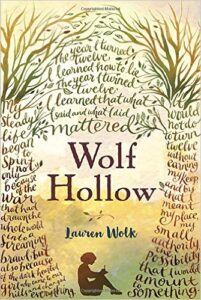 Wolf Hollow
Wolf Hollow
By Lauren Wolk
Dutton Children’s Books (an imprint of Penguin Random House)
$16.99
ISBN: 978-1101994825
Ages 10 and up
On shelves now.
I am not what you might call a very brave reader. This is probably why I primarily consume children’s literature. I might puff myself up with a defense that lists the many fine aspects of this particular type of writing and believe it too, but sometimes when you catch me in a weak moment I might confess that another reason I like reading books for kids is that the content is so very “safe” in comparison to books for adults. Disturbing elements are kept at a minimum. There’s always a undercurrent of hope running through the book, promising that maybe we don’t live in a cold, cruel, calculating universe that cares for us not one jot. Even so, that doesn’t mean that I don’t sometimes have difficulty with books written for, oh say, 10-year-olds. I do. I’m not proud of it, but I do. So when I flipped to the back of Wolf Hollow mid-way through reading it, I want to tell you that I did so not because I wanted to spoil the ending for myself but because I honestly couldn’t turn another page until I knew precisely how everything was going to fall out. In her debut children’s book, Lauren Wolk dives head first into difficult material. A compelling author, the book is making the assumption that child readers will want to see what happens to its characters, even when the foreshadowing is so thick you’d need a knife to cut through it. Even when the ending may not be the happy one everyone expects. And you know what? The book might be right.
It is fair to say that if Betty Glengarry hadn’t moved to western Pennsylvania in the autumn of 1943 then Annabelle would not have needed to become a liar later. Betty looks the part of the blond, blue-eyed innocent, but that exterior hides a nasty spirit. Within days of her arrival she’s threatened Annabelle and said in no uncertain terms that unless she’s brought something special she’ll take it out on the girl’s little brothers. Annabelle is saved from Betty’s threats by Toby, a war veteran with issues of his own. That’s when Betty begins a more concentrated campaign of pain. Rocks are thrown. Accusations made. There’s an incident that comes close to beheading someone. And then, when things look particularly bad, Annabelle disappears. And so does Toby. Now Annabelle finds herself trying to figure out what is right, what is wrong, and whether lies can ever lead people to the truth.
Right off the bat I’m going to tell you that this is a spoiler-rific review. I’ve puzzled it over but I can’t for the life of me figure out how I’d be able to discuss what Wolk’s doing here without giving away large chunks o’ plot. So if you’re the kind of reader who prefers to be surprised, walk on.
All gone? Okay. Let’s get to it.
First and foremost, let’s talk about why this book was rough going for me. I understand that “Wolf Hollow” is going to be categorized and tagged as a “bully book” for years to come, and I get that. But Betty, the villain of the piece, isn’t your average mean girl. I hesitate to use the word “sadistic” but there’s this cold undercurrent to her that makes for a particularly chilling read. Now the interesting thing is that Annabelle has a stronger spine than, say, I would in her situation. Like any good baddie, Betty identifies the girl’s weak spot pretty quickly (Annabelle’s younger brothers) and exploits it as soon as she is able. Even so, Annabelle does a good job of holding her own. It’s when Betty escalates the threat (and I do mean escalates) that you begin to wonder why the younger girl is so adamant to keep her parents in the dark about everything. If there is any weak spot in the novel, it’s a weak spot that a lot of books for middle grade titles share. Like any good author, Wolk can’t have Annabelle tattle to her parents because otherwise the book’s momentum would take a nose dive. Fortunately this situation doesn’t last very long and when Annabelle does at last confide in her very loving parents Betty adds manipulation to her bag of tricks. It got to the point where I honestly had to flip to the back of the book to see what would happen to everyone and that is a move I NEVER do. But there’s something about Betty, man. I think it might have something to do with how good she is at playing to folks’ preexisting prejudices.
Originally author Lauren Wolk wrote this as a novel for adults. When it was adapted into a book for kids she didn’t dumb it down or change the language in a significant manner. This accounts for some of the lines you’ll encounter in the story that bear a stronger import than some books for kids. Upon finding the footsteps of Betty in the turf, Annabelle remarks that they “were deep and sharp and suggested that she was more freighted than she could possibly be.” Of Toby, “He smelled a lot like the woods in thaw or a dog that’s been out in the rain. Strong, but not really dirty.” Maybe best of all, when Annabelle must help her mother create a salve for Betty’s poison ivy, “Together, we began a brew to soothe the hurt I’d prayed for.”
I shall restrain myself from describing to you fully how elated I was when I realized the correlation between Betty down in the well and the wolves that were trapped in the hollow so very long ago. Betty is a wolf. A duplicitous, scheming, nasty girl with a sadistic streak a mile wide. The kind of girl who would be more than willing to slit the throat of an innocent boy for sport. She’s a lone wolf, though she does find a mate/co-conspirator of sorts. Early in the book, Wolk foreshadows all of this. In a conversation with her grandfather, Annabelle asks if, when you raised it right, a wolf could become a dog. “A wolf is not a dog and never will be . . . no matter how you raise it.” Of course you might call Toby a lone wolf as well. He doesn’t seek out the company of other people and, like a wolf, he’s shot down for looking like a threat.
What Wolk manages to do is play with the reader’s desire for righteous justice. Sure Annabelle feels conflicted about Betty’s fate in the will but will young readers? There is no doubt in my mind that young readers in bookclubs everywhere will have a hard time feeling as bad for the antagonist’s fate as Annabelle does. Even at death’s door, the girl manages the twist the knife into Toby one last time. I can easily see kids in bookclub’s saying, “Sure, it must be awful to be impaled in a well for days on end . . . . buuuut . . . .” Wolk may have done too good a job delving deep into Betty’s dark side. It almost becomes a question of grace. We’re not even talking about forgiveness here. Can you just feel bad about what’s happened to the girl, even if it hasn’t changed her personality and even if she’s still awful? Wolk might have discussed after Betty’s death the details of her family situation, but she chooses not to. She isn’t making it easy for us. Betty lives and dies a terrible human being, yet oddly we’re the ones left with the consequences of that.
In talking with other people about the book, some have commented about what it a relief it was that Betty didn’t turn into a sweet little angel after her accident. This is true, but there is also no time. There will never be any redemption for Betty Glengarry. We don’t learn any specific details about her unhappy home life or what it was that turned her into the pint-sized monster she is. And her death comes in that quiet, unexpected way that so many deaths do come to us. Out of the blue and with a whisper. For all that she spent time in the well, she lies until her very last breath about how she got there. It’s like the novel Atonement with its young liar, but without the actual atoning.
Wolk says she wrote this book and based much of it on her own family’s stories. Her memories provided a great deal of the information because, as she says, even the simplest life on a Pennsylvanian farm can yield stories, all thanks to a child’s perspective. There will be people who compare it to To Kill a Mockingbird but to my mind it bears more in common with The Crucible. So much of the book examines how we judge as a society and how that judgment can grow out of hand (the fact that both this book and Miller’s play pivot on the false testimony of young girls is not insignificant). Now I’ll tell you the real reason I flipped to the back of the book early. With Wolf Hollow Wolk threatens child readers with injustice. As you read, there is a very great chance that Betty’s lies will carry the day and that she’ll never be held accountable for her actions. It doesn’t work out that way, though the ending isn’t what you’d call triumphant for Annabelle either. It’s all complicated, but it was that unknowing midway through the book that made me need to see where everything was going. In this book there are pieces to pick apart about lying, truth, the greater good, minority vs. majority opinions, the price of honesty and more. For that reason, I think it very likely it’ll find itself in good standing for a long time to come. A book unafraid to be uneasy.
On shelves now.
Source: Thanks to Penguin Random House for passing on the galley.


By:
Betsy Bird,
on 4/13/2016
Blog:
A Fuse #8 Production
(
Login to Add to MyJacketFlap)
JacketFlap tags:
Reviews,
middle grade fiction,
Best Books,
Candlewick,
Kate DiCamillo,
middle grade historical fiction,
middle grade realistic fiction,
Best Books of 2016,
2016 reviews,
Reviews 2016,
2016 middle grade fiction,
2017 Newbery contenders,
2016 middle grade historical fiction,
Add a tag
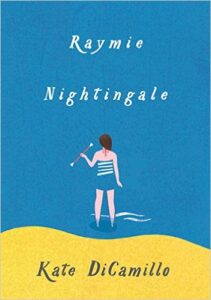 Raymie Nightingale
Raymie Nightingale
By Kate DiCamillo
Candlewick Press
$16.99
ISBN: 978-0-7636-8117-3
Ages 9-12
On shelves now
My relationship to Kate DiCamillo’s books is one built entirely on meaning. Which is to say, the less emotional and meaningful they are, the better I like ‘em. Spaghetti loving horses and girls that live in tree houses? Right up my alley! China rabbits and mice with excessive earlobes? Not my cup of tea. It’s good as a reviewer to know your own shortcomings and I just sort of figured that I’d avoid DiCamillo books when they looked deep and insightful. And when the cover for Raymie Nightingale was released it was easily summarized in one word: Meaningful. A girl, seen from behind, stands ankle-deep in water holding a single baton. Still, I’ve had a good run of luck with DiCamillo as of late and I was willing to push it. I polled my friends who had read the book. The poor souls had to answer the impossible question, “Will I like it?” but they shouldered the burden bravely. Yes, they said. I would like it. I read it. And you know what? I do like it! It is, without a doubt, one of the saddest books I’ve ever read, but I like it a lot. I like the wordplay, the characters, and the setting. I like what the book has to say about friendship and being honest with yourself and others. I like the ending very very much indeed (it has a killer climax that I feel like I should have seen coming, but didn’t). I do think it’s a different kind of DiCamillo book than folks are used to. It’s her style, no bones about it, but coming from a deeper place than her books have in the past. In any case, it’s a keeper. Meaning plus pep.
Maybe it isn’t much of a plan, but don’t tell Raymie that. So far she thinks she has it all figured out. Since her father skipped town with that dental hygienist, things haven’t been right in Raymie’s world. The best thing to do would be to get her father back, so she comes up with what surely must be a sure-fire plan. She’ll just learn how to throw a baton, enter the Little Miss Central Florida Tire competition, win, and when her father sees her picture in the paper he’ll come on home and all will be well. Trouble (or deliverance) comes in the form of Louisiana and Beverly, the two other girls who are taking this class with Ida Nee (the baton-twirling instructor). Unexpectedly, the three girls become friends and set about to solve one another’s problems. Whether it’s retrieving library books from scary nursing home rooms, saving cats, or even lives, these three rancheros have each other’s backs just when they need them most.
DiCamillo has grown as an author over the years. So much so that when she begins Raymie Nightingale she dives right into the story. She’s trusting her child readers to not only stick with what she’s putting down, but to decipher it as well. As a result, some of them are going to experience some confusion right at the tale’s beginning. A strange girl seemingly faints, moaning about betrayal in front of a high-strung baton instructor. Our heroine stands impressed and almost envious. Then we learn about Raymie’s father and the whole enterprise takes a little while to coalesce. It’s a gutsy choice. I suspect that debut authors in general would eschew beginning their books in this way. A pity, since it grabs your attention by an act of simple befuddlement.
Initial befuddlement isn’t enough to keep you going, though. You need a hook to sustain you. And in a book like this, you find that the characters are what stay with you the longest. Raymie in particular. It isn’t just about identification. The kid reading this book is going to impress on Raymie like baby birds impress on sock puppet mamas. She’s like Fone Bone in Jeff Smith’s series. She’s simultaneously a mere outline of a character and a fully fleshed out human being. Still, she’s an avatar for readers. We see things through her rather than with her. And sure, her name is also the title, but names are almost always titles for Kate DiCamillo (exceptions being The Magician’s Elephant, The Tiger Rising, and that Christmas picture book, of course). If you’re anything like me, you’re willing to follow the characters into absurdity and back. When Beverly says of her mother that, “Now she’s just someone who works in the Belknap Tower gift shop selling canned sunshine and rubber alligators” you go with it. You don’t even blink. The setting is almost a character as well. I suspect DiCamillo’s been away from Florida too long. Not in her travels, but in her books. Children’s authors that willingly choose to set their books in the Sunshine State do so for very personal reasons. DiCamillo’s Florida is vastly different from that of Carl Hiaasen’s, for example. It’s a Florida where class exists and is something that permeates everything. Few authors dare to consider lower or lower middle classes, but it’s one of the things I’ve always respected about DiCamillo in general.
Whenever I write a review for a book I play around with the different paragraphs. Should I mention that the book is sad at the beginning of the review or at the end? Where do I put my theory about historical fiction? Should character development be after the plot description paragraph or further in? But when it comes to those written lines I really liked in a book, that kind of stuff shouldn’t have to wait. For example, I adore the lines, “There was something scary about watching an adult sleep. It was as if no one at all were in charge of the world.” DiCamillo excels in the most peculiar of details. One particular favorite was the small paper cups with red riddles on their sides. The Elephantes got them for free because they were misprinted without answers. It’s my secret hope that when DiCamillo does school visits for this book she’ll ask the kids in the audience what the answer to the riddle, “What has three legs, no arms, and reads the paper all day long?” might be. It’s her version of “Why is a raven like a writing desk?”
Now let us discuss a genre: Historical fiction. One question. Why? Not “Why does it exist?” but rather “Why should any novel for kids be historical?” The easy answer is that when you write historical fiction you have built in, legitimate drama. The waters rise during Hurricane Katrina or San Francisco’s on fire. But this idea doesn’t apply to small, quiet novels like Raymie Nightingale. Set in the summer of 1975, there are only the barest of nods to the time period. Sometimes authors do this when the book is semi-autobiographical, as with Jenni Holm’s Sunny Side Up. Since this novel is set in Central Florida and DiCamillo grew up there, there’s a chance that she’s using the setting to draw inspiration for the tale. The third reason authors sometimes set books in the past is that it frees them up from the restrictions of the internet and cell phone (a.k.a. guaranteed plot killers). Yet nothing that happens in Raymie Nightingale requires that cell phones remain a thing of the past. The internet is different. Would that all novels could do away with it. Still, in the end I’m not sure that this book necessarily had to be historical. It’s perfectly fine. A decent time period to exist in. Just not particularly required one way or another.
Obviously the book this feels like at first is Because of Winn-Dixie. Girl from a single parent home finds friendship and (later rather than sooner, in the case of Raymie Nightingale) an incredibly ugly dog. But what surprised me about Raymie was that this really felt more like Winn-Dixie drenched in sadness. Sadness is important to DiCamillo. As an author, she’s best able to draw out her characters and their wants if there’s something lost inside of them that needs to be found. In this case, it’s Raymie’s father, the schmuck who took off with his dental hygienist. Of course all the characters are sad in different ways here. About the time you run across the sinkhole (the saddest of all watery bodies) on page 235 you’re used to it.
Sure, there are parts of the book I could live without. The parts about Raymie’s soul are superfluous. The storyline of Isabelle and the nursing home isn’t really resolved. On the flip side, there are lots of other elements within these pages that strike me as fascinating, like for example why the only men in the book are Raymie’s absent father, an absent swimming coach, a librarian, and a janitor. Now when I was a child I avoided sad children’s books like the plague. You know what won the Newbery in the year that I was born? Bridge to Terabithia. And to this day I eschew them at all costs. But though this book is awash in personal tragedies, it’s not a downer. It’s tightly written and full of droll lines and, yes I admit it. It’s meaningful. But the meaning you cull from this book is going to be different for every single reader. Whip smart and infinitely readable, this is DiCamillo at her best. Time to give it a go, folks.
On shelves now.
Source: Final copy sent from publisher for review.
Song to Listen to With This Book: King of the Road
Alternative Song: I Wanna Hold Your Hand
Like This? Then Try:


By:
Betsy Bird,
on 2/21/2016
Blog:
A Fuse #8 Production
(
Login to Add to MyJacketFlap)
JacketFlap tags:
Reviews,
middle grade fiction,
fantasy,
middle grade fantasy,
funny books,
Alfred A. Knopf,
Random Penguin House,
Susan Hill Long,
funny fantasy,
2016 reviews,
Reviews 2016,
2016 middle grade fantasy,
2016 middle grade fiction,
Add a tag
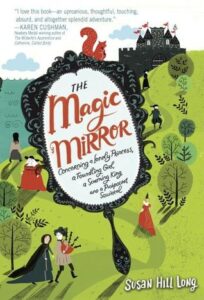 The Magic Mirror: Concerning a Lonely Princess, a Foundling Girl, a Scheming King, and a Pickpocket Squirrel
The Magic Mirror: Concerning a Lonely Princess, a Foundling Girl, a Scheming King, and a Pickpocket Squirrel
By Susan Hill Long
Knopf (an imprint of Penguin Random House)
$16.99
ISBN: 978-0-553-51134-2
Ages 9-12
On shelves May 10th
What do you want from a fairy tale? Magic? Romance? Derring-do? Despicable villainy? Academics and scholars have puzzled and puzzed until their puzzlers were sore over what it is about the European fairy tale genre that so enthralls us. Recently fairy tale lovers have seen the entertainment industry discover that fairy tales are still a primo source of capital. On the book side of things, I’ve seen a distinct uptick in retellings of Cinderella, Little Red Riding Hood, and more in the last five years. Classic fairy tales have it easy. It’s the newbies that have a hard time going. How do you get a foothold in a genre that’s been in existence for centuries? In The Magic Mirror by Susan Hill Long, the author decides to simplify. Merely take the elements that suit the story best (highway robbers, princesses, and just a smidgen of magic) and then weave in some surprisingly stellar writing. The result is fairy tale fare that reminds one of nothing so much as the best of Gail Carson Levine. Funny, friendly, witty and sly, this makes for perfect bedtime reading.
Margaret (or Maggot, depending on who’s talking about her) should technically be grateful for her life. Though she sports a lame foot (an “accident of birth” she’s been told) and is an orphan, she has a roof over her head, food in her belly, and aside from avoiding Thomas, the local bully, not too much trouble in life. But of course she’s desperately lonely, and that’s a problem that’s hard to cure. When she makes the acquaintance of a man with a wooden leg, she receives in a trade a mirror capable of showing anyone their heart’s desire. But what she sees when she peers into it is a strange wild-eyed man she’s never laid eyes on before. When Minka, the woman who cares for Margaret, decides to marry her off, our heroine decides that leg or no leg she is not going to have her life decided for her. And in the course of her adventures she’ll little suspect there are royal mix-ups, a king with little in the way of fatherly feelings, a boy with a bagpipe, and a light-fingered squirrel in her very near future.
Is anyone going to challenge me when I say that comparing a book, any book, to The Princess Bride is never a good idea? The Princess Bride inspires a loving fandom that jealously guards its unique storytelling. Still, there are many familiar tropes in that book/film. A princess, a pirate, giants, swordplay, you name it. When writing a new fairy tale you Harry Potter it. You take those familiar elements and weave them into something new. So when Ms. Long wrote The Magic Mirror she did exactly the same thing. Additionally, by splitting her narrative into an increasingly large cast of characters, she gives it a distinctly Princess Bride-like feel. It has humor and fights and baddies in all the same ways. When Kirkus reviewed this book they said that it was predictable and unbelievable (because of the coincidences in the plot). I’d counter that there’s nothing any more predictable or unbelievable here than you’d find in any modern fairy tale, be it Ella Enchanted or Frozen, and just as much joy.
In this particular case it’s Long’s descriptions and characters that stay with a reader long after the book has been put down. Even the foulest villain has an emotional weak spot, and characters that are set up to seem like baddies at the beginning (like Minka) turn out to be pretty soft in the end. Plus you really root for these characters. Some authors think it necessary to drown their villains in a thick sauce of sadism so that when the heroes triumph it’s an even keener victory. But when writing books for 9-12 year olds there’s no need to pile on the bloodshed. In the right writers’ hands, as long as the antagonist is preventing the heroes from their happy ending, that’s all you really need to do to keep the plot moving at a sharp clip. I liked the people I met in this book, but the descriptions were probably my favorite aspect of the novel. Lines like, “Her voice climbed up the sentence like a ladder, and quavered at the top,” make me happy. Ditto wisdoms like “It’s all in the angle of the squint.” Or a description of a cathedral’s shadows where a character “shuffled away from the creeping dark so that she might escape God’s notice.”
I did experience a palpable sense of relief that it was written today, though. Since Margaret has a physical disability (a foot and leg injured long ago that were never set correctly) there is a brief suggestion at one point that there might be a magical remedy to her problem. I was reminded of a similar middle grade novel Handbook for Dragon Slayers which also starred a girl with an injured limb. In that book a cure for her disability is bandied about and ultimately rejected in an excellent manner. Indeed, the book went on to win a Schneider Family Book Award given annually to books that embody, “an artistic expression of the disability experience for child and adolescent audiences.” Reading The Magic Mirror I had the very clear sense that if this book had been written in the past an easy cure for Margaret’s leg would have been part of the story’s happy ending and that would be that. These days such endings are mildly insulting answers to what, in truth, are very real problems. Happily The Magic Mirror does not fall into such a trap (though sadly the heroine does have some unfortunate thoughts about a successful man with a hunch on his back that did not gel well with the book’s otherwise positive embrace of disability).
As it happens, I did find one particular aspect of the book problematic. This is Ms. Long’s second novel so while the bones of this story are strong there are aspects to the writing that will need a bit of strengthening in the future. Specifically, the exposition. Now the art of exposition is learned, not born. Filling the reader in on a hitherto unknown back-story is no easy task. At best, back-story is woven into the dialogue so naturally the reader is hardly aware that they’re learning about what’s come before. Clunky back-story, in contrast, places huge chunks of it en masse in the same general vicinity of the novel. Alas, near the end of The Magic Mirror the author has set herself up to reveal not just the back-story of our heroine, but of at least three to four other people as well. The result is ultimately somewhat confusing, with new characters popping up (a midwife, a thief’s wife) to fill in the details out of the blue. Without a character guide (which would, admittedly, give away some of the plot) there is little to help kids distinguish between Petra vs. Minka vs. Margaret.
For all that there is a magic mirror in the story the book is pretty devoid of magical activities. You won’t find dragons or wizards or much of anything out of this world here, with the sole exception of the mirror itself. It’s almost a pity that it’s in the title since you could probably hand this title to kids that only like realism (and they do indeed exist) and they’d get just as much out of it as the most ravenous fantasy fan. While it’s not a perfect novel, it is a ripping good yarn that keeps you enthralled from page one onward. Will you see where it’s going? Maybe. But you’ll enjoy the sights along the way. Fine fantastical stuff.
For ages 9-12.
On shelves May 10th.
Like This? Then Try:

 No excuses! These are just the books that I read in 2016 that I thought knocked it out of the park. These aren’t the “best of the year”. These are just the books that were particularly good and that somehow crossed my radar. I read a lot more than what you’ll see here, but I loved these the best. For your consideration:
No excuses! These are just the books that I read in 2016 that I thought knocked it out of the park. These aren’t the “best of the year”. These are just the books that were particularly good and that somehow crossed my radar. I read a lot more than what you’ll see here, but I loved these the best. For your consideration:





























Thanks for the mentions!
I read aloud FIVE CHILDREN ON THE WESTERN FRONT to my 4th grade class last year and they loved it. None had read FIVE CHILDREN AND IT. I also gave it to a kid this year who reads literary sorts of things.
My Horn Book review of CLOUD AND WALLFISH is here: http://www.hbook.com/2016/11/choosing-books/review-of-the-week/review-of-cloud-and-wallfish/
Oh yeah! I had gotten out of reading middle school fiction because life intervened. Looks like a few here that will entice me to return. Thanks for the list.